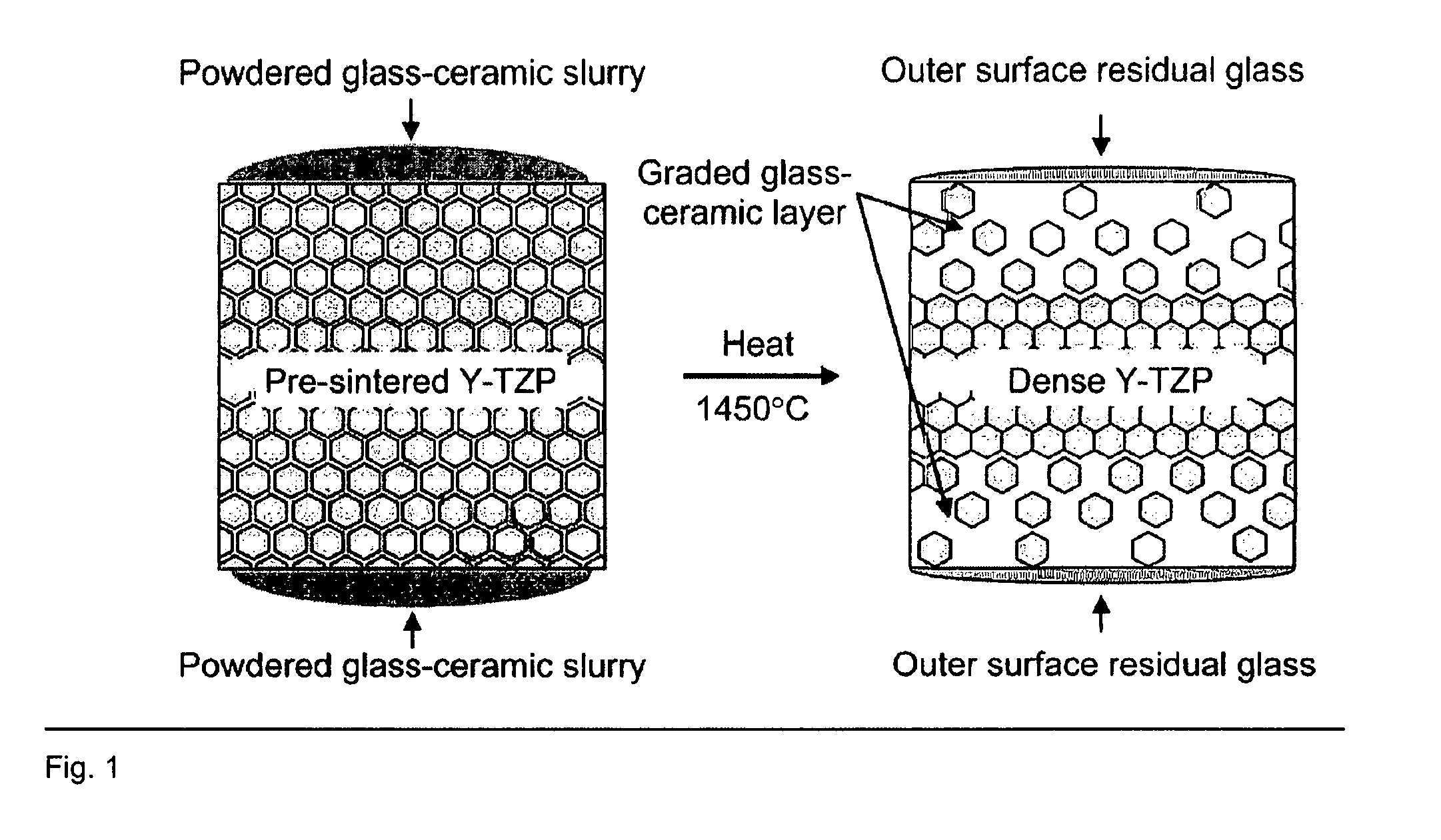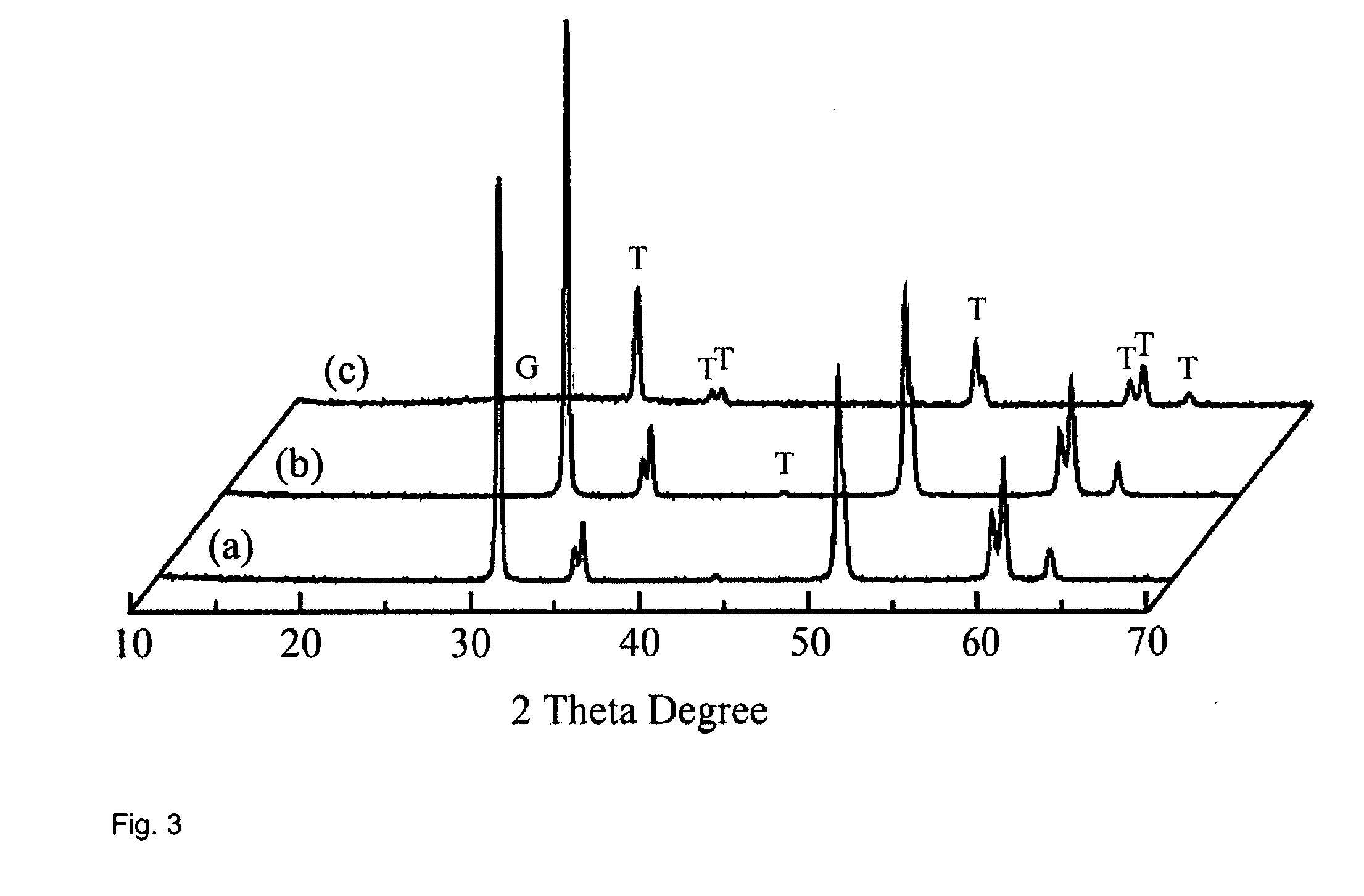Graded glass/zirconia/glass structures for damage resistant ceramic dental and orthopedic prostheses
a ceramic and dental technology, applied in the field of dental and orthopedic prostheses, can solve the problems of loss of function, loss of aesthetics, and loss of function, and achieve the effect of minimizing the fracture problem of ceramic prostheses
- Summary
- Abstract
- Description
- Claims
- Application Information
AI Technical Summary
Benefits of technology
Problems solved by technology
Method used
Image
Examples
example 1
[0043]Green compacts were formed from a yttria-stabilized zirconia powder, 5.18 wt % Y2O3, 0.25 wt % Al2O3, and a mean particle size of diameter approximately 28 nm with a specific surface area of 16 m2 / g (TZ-3Y-E grade, Tosoh, Tokyo, Japan) using a cold isostatic press at 172 MPa (25 kpsi). The green compacts were presintered at temperatures between 1100 and 1400° C. for 1 hour in air. Infiltration and densification were carried out at 1450° C. for 2 hours using a custom developed glass-ceramic powder of the type described above. A heating and cooling rate of 800° C. / hour was employed. Two glass-ceramic compositions were prepared for infiltration of Y-TZP. The glass-ceramic powder composition 1 consisted of the following main oxides (i.e. at 1.0 weight percent or more): SiO2 (67.25 wt %), Al2O3 (10.83 wt %), K2O (9.22 wt %), Na2O (6.61 wt %), CaO (2.68 wy %), Tb4O7 (1.84 wt %), BaO (1.02 wt %), and a small amount of MgO. The glass-ceramic powder composition 2 consisted of SiO2 (67....
example 2
[0045]A standard three-point bending test with a span of 20 mm was used to fracture rectangular bar specimens at a crosshead speed of 1 mm / min on a computer-controlled universal testing machine (model 5566, Instron Corp., Canton. Mass.). Flexural strength, σ, was determined using the equation below for homogeneous zirconia and for the two G / Z / G compositions fabricated from infiltrating 1400° C. for 1 hour presintered Y-TZP with in-house prepared glass-ceramic powders (composition 1 or 2) at 1450° C. for 2 hours:
σ=3Pl / 2wb2
where P is the breaking load; l is the test span; and w and b are the specimen width and thickness, respectively. Flexural strengths of the two G / Z / G compositions and the homogeneous zirconia control are reported in Table 1. Data are presented in the form of mean and standard deviation (mean±SD) for a specimen size n=6. As can be seen, flexural strengths for G / Z / G infiltrated with glass-ceramic composition 1 and 2 were approximately 43% and 47%, respectively, highe...
example 3
[0046]Ceramic plates were epoxy bonded to polycarbonate bases and loaded on the top surface, emulating ceramic dental crowns on tooth dentin support subjected to occlusion or ceramic liner on polyethylene backing subjected articulation in total hip replacement. Critical loads for the onset of ceramic bottom surface radial cracking (an indication of flexural strength of the ceramic plates) were measured for homogeneous zirconia and for G / Z / G (d=1.5 or 0.4 mm) fabricated from infiltrating 1400° C. for 1 hour presintered T-YZP with an in-house prepared glass-ceramic powder (composition 1) at 1450° C. for 2 hours. Six specimens (n=6) were fabricated from two different batches for each G / Z / G thickness: 20×20×1.5 mm3 or 20×20×0.4 mm3. Variations in critical loads between specimens fabricated from the two different batches were similar to those prepared from the same batch, being typically approximately 10%. As shown in FIG. 4, critical loads for G / Z / G infiltrated at 1400° C. for 1 hour pr...
PUM
| Property | Measurement | Unit |
|---|---|---|
| temperature | aaaaa | aaaaa |
| temperature | aaaaa | aaaaa |
| flexural strength | aaaaa | aaaaa |
Abstract
Description
Claims
Application Information
 Login to View More
Login to View More - R&D
- Intellectual Property
- Life Sciences
- Materials
- Tech Scout
- Unparalleled Data Quality
- Higher Quality Content
- 60% Fewer Hallucinations
Browse by: Latest US Patents, China's latest patents, Technical Efficacy Thesaurus, Application Domain, Technology Topic, Popular Technical Reports.
© 2025 PatSnap. All rights reserved.Legal|Privacy policy|Modern Slavery Act Transparency Statement|Sitemap|About US| Contact US: help@patsnap.com



